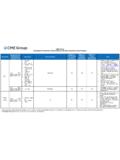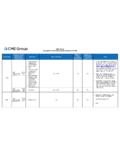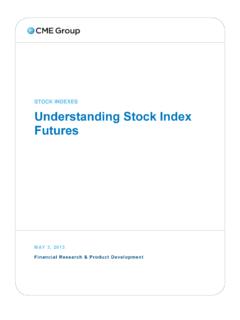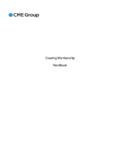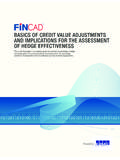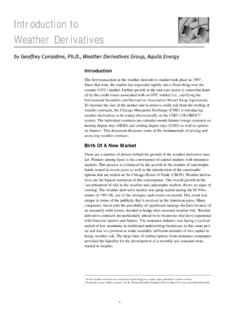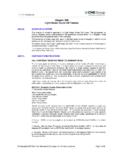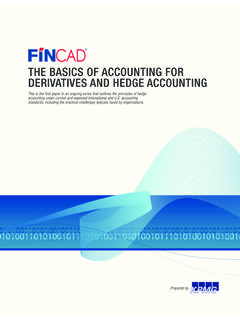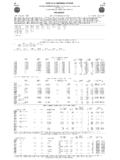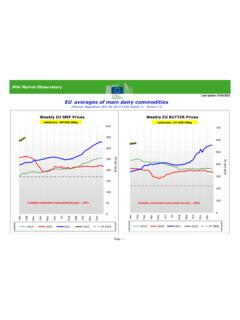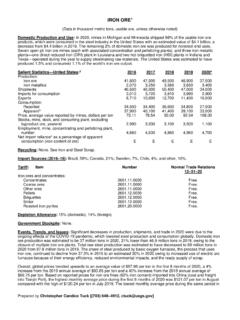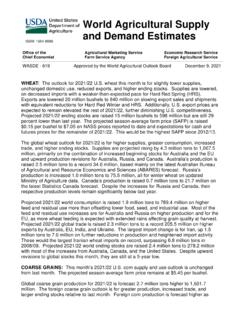Transcription of CME SPAN®
1 CME SPAN Standard Portfolio Analysis of Risk 2010 CME Group. All rights reserved 2 Developed in 1988 by Chicago Mercantile Exchange Inc. to effectively assess risk on an overall portfolio basis. SPAN is a market simulation based Value At Risk system which has been reviewed and approved by market regulators and participants world wide. SPAN is the official Performance Bond mechanism of 54 exchanges and clearing organizations world-wide, making it the global standard for portfolio margining. SPAN s risk based margin requirements allows for effective margin coverage while preserving efficient use of capital. SPAN assesses risk for a wide variety of financial instruments including: futures, options, physicals, equities, or any combination. CME SPAN - Standard Portfolio Analysis of Risk 2010 CME Group. All rights reserved 3 SPAN assesses the risk of a portfolio, by calculating the maximum likely loss that could be suffered by the portfolio based on parameters set by the margin-setting authority, usually an exchange or clearing organization.
2 The core of SPAN risk analysis is to simulate potential market moves and calculate the profit or loss on individual contracts given the market moves. Exchanges may determine any number of market scenarios to be included in the SPAN analysis. Most SPAN exchanges and clearing organizations use 16 scenarios. CME SPAN - Objectives 2010 CME Group. All rights reserved 4 SPAN groups together financial instruments with the same underlying for analysis. For example, Futures on an Equity Index and Options on the Equity Index would be grouped together for analysis. Each product is referred to as a Combined commodity . SPAN uses parameters set by the exchange or clearing organization to evaluate a portfolio with the following two step analysis: Step 1: SPAN first analyzes the risk of each Combined commodity in isolation from other Combined Commodities.
3 Step 2: SPAN then seeks risk reducing offsets between Combined Commodities. CME SPAN - Methodology Scan Risk Arrays 2010 CME Group. All rights reserved 6 The core of SPAN risk analysis to simulate potential market moves and calculate the profit or loss on individual contracts. Exchanges or clearing organizations may determine any number of market scenarios to be included in SPAN analysis. Most SPAN exchanges or clearing organizations use 16 scenarios. The 16 scenarios are referred to as SPAN Risk Arrays. CME SPAN - Scan Risk 2010 CME Group. All rights reserved 7 SPAN Risk Arrays represent a contract's hypothetical gain/loss under a specific set of market conditions from a set point in time to a specific point in time in the future. Risk Arrays typically consist of 16 profit/loss scenarios for each contract. Each Risk Array scenario is comprised of a different market simulation, moving the underlying price up or down and/or moving volatility up or down.
4 The risk array representing the maximum likely loss becomes the Scan Risk for the portfolio. CME SPAN - Scan Risk Arrays 2010 CME Group. All rights reserved 8 The next slide demonstrates the Scanning Risk calculation for an S&P500 portfolio: Long 1 Sep 2010 SP Futures (price is 1100) Short 1 Sep 2010 SP 1000 Call Option (implied volatility is 28%) The Price Scan Range is $22,500 or 90 points (CVF for SP500 is $250, $22,500/$250 = 90points) The Volatility Scan Range for SP500 is 7% CME SPAN - Scan Risk Example 2010 CME Group. All rights reserved 9 CME SPAN - Scan Risk Example Scenario SP Underlying Price Move Volatility Move SP Future Gain/Loss SP Option Gain/Loss Portfolio Gain/Loss 1 UNCHANGED UP 0 1,807 1807 2 UNCHANGED DOWN 0 -1,838 -1,838 3 UP 33% UP -7,499 7,899 400 4 UP 33% DOWN -7,499 5,061 -2,438 5 DOWN 33% UP 7,499 -3,836 3,663 6 DOWN 33% DOWN 7,499 -8,260 -761 7 UP 67% UP -15,001 14,360 -641 8 UP 67% DOWN -15,001 12,253 -2,748 9 DOWN 67% UP 15,001 -8,949 6,052 10 DOWN 67% DOWN 15,001 -13,980 1,021 11 UP 100% UP -22,500 21,107 -1,393 12 UP 100% DOWN -22,500 19,604 -2,896 13 DOWN 100% UP 22,500 -13,455 9,045 14 DOWN 100% DOWN 22,500 -18,768 3,732 15 UP 300% UNCHANGED -22,275 21,288 -987 16 DOWN 300% UNCHANGED 22,275 -9,160 13,115 Largest Potential Loss = SPAN Risk 13,115 2010 CME Group.
5 All rights reserved 10 Deep out-of-the-money short options may pose significant risk, as unusually large price changes may result in unexpectedly large losses, particularly as expiration nears. SPAN accounts for this risk by including Extreme Scenarios in the Risk Arrays. Extreme Scenarios may be used to simulate a significant market move designed to shock deep out-of-the-money options. Extreme Scenarios are determined by the Exchange or Clearing Organization. CME uses a market move equal to 3 times the Price Scan Range for a given product. The resulting gain or loss is then multiplied by a percentage of 33% to determine the potential exposure. CME SPAN - Scan Risk Extreme Scenarios 2010 CME Group. All rights reserved 11 CME SPAN - Composite Delta Scenarios Scenario Underlying Price Change as % of Price Scan Range Probability Weight 1 UNCHANGED 3 UP 33% 5 DOWN 33% 7 UP 67% 9 DOWN 67% 11 UP 100% 13 DOWN 100% Composite Delta is derived as the weighted average of the deltas, where the weights are associated with each underlying price scan point.
6 Below is an example of the 7 Delta Points used by CME: SPAN Analysis Spread Types & Formations Short Option Minimum & Delivery Add-On Charge Net Option Value 2010 CME Group. All rights reserved 13 Intra- commodity Spread : Evaluate the basis risk between contract periods with different expirations within the same product. Spreads are prioritized by lowest charge. Inter- commodity Spread : Evaluate credit available for offsetting positions in related instruments. Spreads are prioritized by greatest total savings. SPAN forms Intra- commodity Spreads before Inter- commodity Spreads. Super Inter- commodity Spread : Allows Inter- commodity Spreads to be evaluated before Intra- commodity Spreads. Inter-Exchange Spread Credit: Allows spreads to be formed for portfolios containing products listed on multiple Exchanges, as defined by the Exchange.
7 The formation of Inter-Exchange Spreads is similar to process of forming Inter- commodity Spreads, however each Exchange can only provide a credit for its own products. CME SPAN - Spread Types & Formation 2010 CME Group. All rights reserved 14 Since futures prices do not correlate exactly across contract months, a gain in one month may not exactly offset losses in another month. An Intra- commodity Spread Charge can be set in SPAN to cover the risk of calendar spread positions. The Intra- commodity Spread Charge can be tailored for contract pairs or specified groups of contracts. There is no limit to the number of contract legs that can be specified in an Intra- commodity Spread, also known as tiered intra- commodity spreading. The Intra- commodity Spread Charge can also be tailored to specific calendar months. For example, a March versus September calendar spread can have a different charge rate than a March versus December calendar spread.
8 This is also known as series specific intra- commodity spreading. The next slide shows an example of an Intra- commodity Spread for a portfolio with 1 long September 2010 and 1 short September 2010 Eurodollar. CME SPAN - Intra- commodity Spread Risk 2010 CME Group. All rights reserved 15 The Intra- commodity Spread Charge for Nov 2010 vs. Dec 2010 is $200. Since the gains on Nov ED exactly offset the losses on Dec ED, the Scan Risk is $0. Therefore, the Intra- commodity Spread Charge of $200 becomes SPAN Risk. CME SPAN - Intra- commodity Spread Example Scenario SP Underlying Price Move Volatility Move Nov ED Gain/Loss Dec ED Gain/Loss Portfolio Gain/Loss 1 UNCHANGED UP 0 0 0 2 UNCHANGED DOWN 0 0 0 3 UP 33% UP -250 250 0 4 UP 33% DOWN -250 250 0 5 DOWN 33% UP 250 -250 0 6 DOWN 33% DOWN 250 -250 0 7 UP 67% UP -500 500 0 8 UP 67% DOWN -500 500 0 9 DOWN 67% UP 500 -500 0 10 DOWN 67% DOWN 500 -500 0 11 UP 100% UP -750 750 0 12 UP 100% DOWN -750 750 0 13 DOWN 100% UP 750 -750 0 14 DOWN 100% DOWN 750 -750 0 15 UP 300% UNCHANGED -743 743 0 16 DOWN 300% UNCHANGED 743 -743 0 2010 CME Group.
9 All rights reserved 16 CME SPAN - Inter- commodity Spread Risk Combined commodity Position Outright PB Requirement Recognize Spread Credit SPAN Requirement SP Long 1 $22,500 NP Short 2 $14,000 x 2 = $28,000 Total $50,500 X 85% = $42,925 $7,575 To recognize the risk reducing aspects of portfolios containing off-setting positions in highly correlated instruments, SPAN forms Inter- commodity Spreads. Inter- commodity Spreads produce credits which reduce the overall performance bond or margin requirement. The universe of recognized spreads, rates, and priority are determined by the Exchange. Below is an example of 1 Long SP future and 2 Short Nasdaq futures. The recognized spread ratio is 1 SP vs. 2 ND and the spread credit is 85%. 2010 CME Group. All rights reserved 17 Delta Based Spreading is performed after the Scan Risk or Scanning process.
10 One result of the Scanning process for each Combined commodity is a Net Delta position, which is an estimate of market exposure that has not been offset within the Combined commodity which is available to be offset between Combined Commodities. Each exchange defines a table of recognized Inter- commodity Spread formations and the margin credit to apply for such formations. SPAN takes the Inter- commodity spread table and seeks out the defined spread formations, giving margin credit for each spread formed. A Delta based spread may contain any number of spread legs. CME SPAN - Inter- commodity Delta Based Spreading 2010 CME Group. All rights reserved 18 Another method of recognizing offsetting positions between Combined Commodities is Scanning Based Spreading. Scanning Based Spreading recognizes risk offsets among Combined Commodities by scanning them together.
